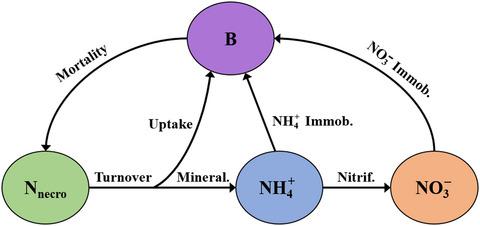当前位置:
X-MOL 学术
›
Glob. Change Biol.
›
论文详情
Our official English website, www.x-mol.net, welcomes your
feedback! (Note: you will need to create a separate account there.)
Elevated temperature increases the accumulation of microbial necromass nitrogen in soil via increasing microbial turnover.
Global Change Biology ( IF 10.8 ) Pub Date : 2020-06-07 , DOI: 10.1111/gcb.15206 Xu Wang 1, 2 , Chao Wang 1 , M Francesca Cotrufo 3 , Lifei Sun 1 , Ping Jiang 1 , Ziping Liu 4 , Edith Bai 1, 4
Global Change Biology ( IF 10.8 ) Pub Date : 2020-06-07 , DOI: 10.1111/gcb.15206 Xu Wang 1, 2 , Chao Wang 1 , M Francesca Cotrufo 3 , Lifei Sun 1 , Ping Jiang 1 , Ziping Liu 4 , Edith Bai 1, 4
Affiliation

|
Microbial‐derived nitrogen (N) is now recognized as an important source of soil organic N. However, the mechanisms that govern the production of microbial necromass N, its turnover, and stabilization in soil remain poorly understood. To assess the effects of elevated temperature on bacterial and fungal necromass N production, turnover, and stabilization, we incubated 15N‐labeled bacterial and fungal necromass under optimum moisture conditions at 10°C, 15°C, and 25°C. We developed a new 15N tracing model to calculate the production and mineralization rates of necromass N. Our results showed that bacterial and fungal necromass N had similar mineralization rates, despite their contrasting chemistry. Most bacterial and fungal necromass 15N was recovered in the mineral‐associated organic matter fraction through microbial anabolism, suggesting that mineral association plays an important role in stabilizing necromass N in soil, independently of necromass chemistry. Elevated temperature significantly increased the accumulation of necromass N in soil, due to the relatively higher microbial turnover and production of necromass N with increasing temperature than the increases in microbial necromass N mineralization. In conclusion, we found elevated temperature may increase the contribution of microbial necromass N to mineral‐stabilized soil organic N.
中文翻译:

升高的温度通过增加微生物周转量来增加土壤中微生物坏死氮的积累。
如今,微生物源氮(N)已被认为是土壤有机氮的重要来源。然而,控制微生物坏死氮的产生,其周转和在土壤中稳定的机制仍知之甚少。为了评估高温对细菌和真菌坏死氮的产生,更新和稳定的影响,我们在10°C,15°C和25°C的最佳湿度条件下孵育了15种N标记的细菌和真菌坏死。我们开发了一个新的15 N示踪模型来计算坏死N的产生和矿化速率。我们的结果表明,尽管细菌和真菌坏死N的化学性质不同,但它们具有相似的矿化速率。大多数细菌和真菌坏死15氮通过微生物合成代谢从与矿物质有关的有机物组分中回收,这表明矿物质缔合在稳定土壤中的坏死氮中起着重要作用,而与坏死化学无关。升高的温度显着增加了土壤中坏死氮的积累,这是因为随着温度的升高,微生物周转率和坏死氮的产生要高于微生物死矿质N矿化的增加。总之,我们发现升高温度可能会增加微生物坏死氮对矿物质稳定的土壤有机氮的贡献。
更新日期:2020-08-11
中文翻译:

升高的温度通过增加微生物周转量来增加土壤中微生物坏死氮的积累。
如今,微生物源氮(N)已被认为是土壤有机氮的重要来源。然而,控制微生物坏死氮的产生,其周转和在土壤中稳定的机制仍知之甚少。为了评估高温对细菌和真菌坏死氮的产生,更新和稳定的影响,我们在10°C,15°C和25°C的最佳湿度条件下孵育了15种N标记的细菌和真菌坏死。我们开发了一个新的15 N示踪模型来计算坏死N的产生和矿化速率。我们的结果表明,尽管细菌和真菌坏死N的化学性质不同,但它们具有相似的矿化速率。大多数细菌和真菌坏死15氮通过微生物合成代谢从与矿物质有关的有机物组分中回收,这表明矿物质缔合在稳定土壤中的坏死氮中起着重要作用,而与坏死化学无关。升高的温度显着增加了土壤中坏死氮的积累,这是因为随着温度的升高,微生物周转率和坏死氮的产生要高于微生物死矿质N矿化的增加。总之,我们发现升高温度可能会增加微生物坏死氮对矿物质稳定的土壤有机氮的贡献。











































 京公网安备 11010802027423号
京公网安备 11010802027423号